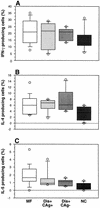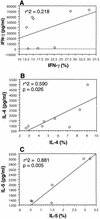Differences in the frequency of cytokine-producing cells in antigenemic and nonantigenemic individuals with bancroftian filariasis
- PMID: 9529056
- PMCID: PMC108063
- DOI: 10.1128/IAI.66.4.1377-1383.1998
Differences in the frequency of cytokine-producing cells in antigenemic and nonantigenemic individuals with bancroftian filariasis
Abstract
Individuals with clinical manifestations of lymphatic filariasis may be currently infected or not. Twenty-five individuals from a Wuchereria bancrofti-endemic area of Brazil were classified as being asymptomatic microfilaremic individuals, antigenemic individuals with clinical filariasis, or nonantigenemic individuals with clinical filariasis. Intracellular cytokine staining of mitogen-stimulated peripheral blood mononuclear cells (PBMC) showed that the frequency of either gamma interferon (IFN-gamma)- or interleukin-4 (IL-4)-producing cells was higher in the nonantigenemic individuals with clinical filariasis than in the asymptomatic microfilaremic individuals (geometric means, 22.1 versus 10.7% [P = 0.02] and 2.9 versus 1.4% [P = 0.01], respectively). When the asymptomatic microfilaremic individuals and antigenemic individuals with clinical filariasis were grouped together to constitute all actively infected individuals, the frequency of IFN-gamma-producing cells was also lower than in the nonantigenemic individuals with clinical filariasis (P = 0.04). Likewise, the frequency of IL-4-producing cells in the actively infected individuals was also lower than in the nonantigenemic individuals with clinical filariasis (P = 0.02). No differences in the frequency of IFN-gamma-, IL-4-, or IL-5-producing cells in purified CD4 T lymphocytes were found among the groups. These findings suggest that the presence of antigenemia, which is an indicator of current active infection, is closely associated with the frequency of IFN-gamma- and IL-4-producing cells in lymphatic filariasis. The differences found in the frequency of cytokine-producing cells among the three groups appear to be due to a subset of cells other than CD4 T cells.
Figures




Similar articles
-
The presence or absence of active infection, not clinical status, is most closely associated with cytokine responses in lymphatic filariasis.J Infect Dis. 1996 Jun;173(6):1453-9. doi: 10.1093/infdis/173.6.1453. J Infect Dis. 1996. PMID: 8648219
-
Th1-like antifilarial immune responses predominate in antigen-negative persons.Infect Immun. 1996 Aug;64(8):2962-7. doi: 10.1128/iai.64.8.2962-2967.1996. Infect Immun. 1996. PMID: 8757821 Free PMC article.
-
Parasite antigenemia without microfilaremia in bancroftian filariasis.Am J Trop Med Hyg. 1996 Sep;55(3):333-7. doi: 10.4269/ajtmh.1996.55.333. Am J Trop Med Hyg. 1996. PMID: 8842125
-
Bancroftian filariasis: the patterns of filarial-specific immunoglobulin G1 (IgG1), IgG4, and circulating antigens in an endemic community of northeastern Tanzania.Am J Trop Med Hyg. 1996 Jul;55(1):69-75. doi: 10.4269/ajtmh.1996.55.69. Am J Trop Med Hyg. 1996. PMID: 8702025
-
Regulation of the immune response in lymphatic filariasis: perspectives on acute and chronic infection with Wuchereria bancrofti in South India.Parasite Immunol. 2001 Jul;23(7):389-99. doi: 10.1046/j.1365-3024.2001.00399.x. Parasite Immunol. 2001. PMID: 11472558 Review.
Cited by
-
An association of Aquaporin-4 with the immunoregulation of liver pathology in mice infected with Schistosoma japonicum.Parasit Vectors. 2015 Jan 21;8:37. doi: 10.1186/s13071-015-0650-7. Parasit Vectors. 2015. PMID: 25604731 Free PMC article.
-
Insights into the pathogenesis of disease in human lymphatic filariasis.Lymphat Res Biol. 2013 Sep;11(3):144-8. doi: 10.1089/lrb.2013.0021. Lymphat Res Biol. 2013. PMID: 24044755 Free PMC article. Review.
-
Dynamics of Th17 cells and their role in Schistosoma japonicum infection in C57BL/6 mice.PLoS Negl Trop Dis. 2011 Nov;5(11):e1399. doi: 10.1371/journal.pntd.0001399. Epub 2011 Nov 15. PLoS Negl Trop Dis. 2011. PMID: 22102924 Free PMC article.
-
Regulatory effects of Th1-type (IFN-gamma, IL-12) and Th2-type cytokines (IL-10, IL-13) on parasite-specific cellular responsiveness in Onchocerca volvulus-infected humans and exposed endemic controls.Immunology. 1999 Jun;97(2):219-25. doi: 10.1046/j.1365-2567.1999.00018.x. Immunology. 1999. PMID: 10447735 Free PMC article.
-
Immunopathogenesis of lymphatic filarial disease.Semin Immunopathol. 2012 Nov;34(6):847-61. doi: 10.1007/s00281-012-0346-4. Epub 2012 Oct 3. Semin Immunopathol. 2012. PMID: 23053393 Free PMC article. Review.
References
-
- Albuquerque M F M, Marzochi M C, Sabroza P C, Braga M C, Padilha T, Silva M C M, Silva M R F, Schindler H C, Maciel M A, Souza W, Furtado A F. Bancroftian filariasis in two urban areas of Recife, Brazil: pre-control observations on infection and disease. Trans R Soc Trop Med Hyg. 1995;89:373–377. - PubMed
-
- al-Rayes H, Pachas W, Mirza N, Ahern D J, Geha R S, Vercelli D. IgE regulation and lymphokine patterns in aging humans. J Allergy Clin Immunol. 1992;90:630–636. - PubMed
-
- Chanteau S, Glaziou P, Luquiaud P, Plichart C, Moulia-Pelat J P, Cartel J L. Og4C3 circulating antigen, anti-Brugia malayi IgG and IgG4 titers in Wuchereria bancrofti infected patients, according to their parasitological status. Trop Med Parasitol. 1994;45:255–257. - PubMed
-
- de Almeida A B, Maia e Silva M C, Maciel M A, Freedman D O. The presence or absence of active infection, not clinical status, is most closely associated with cytokine responses in lymphatic filariasis. J Infect Dis. 1996;173:1453–1459. - PubMed
Publication types
MeSH terms
Substances
Grants and funding
LinkOut - more resources
Full Text Sources
Research Materials

